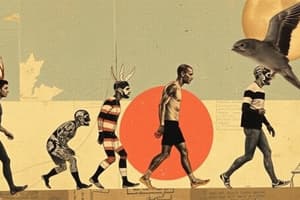Podcast
Questions and Answers
Which of the following best describes the core principle of Lamarckism?
Which of the following best describes the core principle of Lamarckism?
- Changes acquired during an organism's lifetime can be passed on to its offspring. (correct)
- Species evolve through natural selection acting on inherited traits.
- Evolutionary change is driven by random chance and has no directionality.
- Genetic mutations are the primary driver of evolutionary change.
Why did Lamarck's theory of inheritance face significant criticism?
Why did Lamarck's theory of inheritance face significant criticism?
- It contradicted the principles of natural selection proposed by Darwin.
- It lacked a mechanism to explain how acquired traits could be heritable. (correct)
- It suggested that species were immutable and could not evolve over time.
- It relied too heavily on mathematical models of population genetics.
According to Lamarck, how did the giraffe's long neck evolve?
According to Lamarck, how did the giraffe's long neck evolve?
- Giraffes stretched their necks to reach high leaves, and this trait was passed to offspring. (correct)
- Giraffes mimicked other animals with long necks, and this behavior led to evolutionary change.
- A sudden mutation caused a drastic increase in neck length in a single generation.
- Giraffes with slightly longer necks had a survival advantage and reproduced more.
Which of the following is an example used to support the concept of use and disuse in Lamarck's theory?
Which of the following is an example used to support the concept of use and disuse in Lamarck's theory?
What is the central idea behind neo-Lamarckism?
What is the central idea behind neo-Lamarckism?
What was the outcome of Weismann's experiment involving the removal of mice tails over multiple generations?
What was the outcome of Weismann's experiment involving the removal of mice tails over multiple generations?
How does modern genetics challenge the core concept of Lamarckism?
How does modern genetics challenge the core concept of Lamarckism?
Which of the following statements aligns with the criticisms raised against Lamarckism?
Which of the following statements aligns with the criticisms raised against Lamarckism?
What was Jean-Baptiste de Monet Lamarck's major publication outlining his theory of evolution?
What was Jean-Baptiste de Monet Lamarck's major publication outlining his theory of evolution?
How did Lamarck interpret the observation that older seashells appeared simpler than more recent ones?
How did Lamarck interpret the observation that older seashells appeared simpler than more recent ones?
In McDougall's experiment, what was the intended purpose of the 'T' shaped tank with two exits?
In McDougall's experiment, what was the intended purpose of the 'T' shaped tank with two exits?
What observation did F.B. Sumner make regarding mice reared in different temperatures?
What observation did F.B. Sumner make regarding mice reared in different temperatures?
Which of the following best describes the role of 'internal forces of life ' in Lamarck's propositions?
Which of the following best describes the role of 'internal forces of life ' in Lamarck's propositions?
How does Lamarck's concept of 'use and disuse' explain the reduced muscles of the external ear in humans?
How does Lamarck's concept of 'use and disuse' explain the reduced muscles of the external ear in humans?
How would Lamarck explain the absence of limbs in snakes?
How would Lamarck explain the absence of limbs in snakes?
What is the significance of August Weismann's theory of continuity of germplasm in the context of Lamarckism?
What is the significance of August Weismann's theory of continuity of germplasm in the context of Lamarckism?
How does Mendel's law of inheritance contradict Lamarck's theory?
How does Mendel's law of inheritance contradict Lamarck's theory?
What is a key difference between Lamarckism and Darwinism?
What is a key difference between Lamarckism and Darwinism?
What is one argument made by Neo-Lamarckians?
What is one argument made by Neo-Lamarckians?
Which of the following statements accurately describes one of the four propositions of Lamarckism?
Which of the following statements accurately describes one of the four propositions of Lamarckism?
Flashcards
Lamarckism
Lamarckism
A theory of evolution stating that physical changes acquired during an organism's lifetime can be inherited by its offspring.
Use and Disuse
Use and Disuse
The principle that organs used continuously become highly developed, while disuse leads to degeneration.
Lamarckian Inheritance
Lamarckian Inheritance
The concept that traits changed or acquired during an individual's lifetime can be passed down to their offspring.
Neo-Lamarckism
Neo-Lamarckism
Signup and view all the flashcards
First Proposition of Lamarckism
First Proposition of Lamarckism
Signup and view all the flashcards
Second Proposition of Lamarckism
Second Proposition of Lamarckism
Signup and view all the flashcards
Third Proposition of Lamarckism
Third Proposition of Lamarckism
Signup and view all the flashcards
Fourth Proposition of Lamarckism
Fourth Proposition of Lamarckism
Signup and view all the flashcards
Study Notes
Lamarckism
- A theory of evolution based on the principle that physical changes in organisms during their lifetime can be transmitted to their offspring.
- Proposed by Jean-Baptiste de Monet Lamarck in 1809 in Philosophie Zoologique.
- The theory describes a two-part mechanism where change is gradually introduced and passed through generations.
- It is also known as the theory of transformation.
- The theory states that all physical changes occurring in an individual's lifetime are inherited by its offspring.
Acquired Characteristics
- An acquired character is produced by the organism's behavior, usually as a response to the environment.
- Ancestral giraffes stretched their necks to reach leaves, and weightlifters develop muscles as examples
- Modern genetics disproves the inheritance of acquired biological characters and that genetic differences are due to random mutations.
Four Postulates of Lamarckism
- Living organisms and their parts tend to increase in size continuously due to internal forces.
- New organs form in response to a new need.
- Continuous use of an organ leads to its development, while disuse leads to degeneration.
- Changes acquired during an individual's lifetime are inherited.
- Aquatic birds developing webbed feet by stretching the skin, limbs disappearing in snakes due to disuse, and the long necks of giraffes are examples.
- Reduced muscles of the external ear in humans compared to animals like dogs and rabbits as another example.
Use and Disuse
- Constant straining to reach high branches could lead to an elongated neck in giraffes.
- Straining toes to swim could lead to elongated, webbed toes in water birds.
- Disuse leads to trait reduction, wings of penguins.
Lamarckian Inheritance
- Acquired traits are passed down to offspring.
- Giraffes with acquired long necks would have offspring with long necks, instead of the shorter necks they were born with.
- Lamarckian inheritance has been disproven by hereditary genetics.
- Evolutionary change occurs gradually and constantly and species start simple and move towards complexity
Criticism of Lamarckism
- Lamarck's theory was subject to severe criticism; two scientists, Cuvier and Weismann, were great critics.
Objections to Lamarckism
- The tendency to increase in size is not universal; there are instances of size reduction.
- New organs do not develop in response to need.
- Changes acquired during an organism's lifetime cannot be inherited.
- Somatic changes are non-heritable, while germplasm changes are inheritable.
- August Weismann removed the tails of mice for 22 generations, but offspring still had tails.
- Mendel's law of inheritance disproved Lamarck's theory.
Neo-Lamarckism
- A modification of Lamarck's theory to align with modern knowledge.
- It stresses the direct effect of changed environments on organisms.
- Only modifications influencing germ cells are transferred to the next generation.
- Adaptations are universal and happen through the relationship of structure, function, and environment.
- Environmental changes alter habits, leading to new structures that become inheritable traits.
Neo-Lamarckian Experiments - McDougall
- McDougall tried to prove that learning is an inheritable acquired character through experiments on rats.
- Rats were trained to escape a 'T' shaped tank with a lighted exit that gave electric shocks and a dark exit with cheese.
- Over generations, rats made fewer mistakes and learned faster, suggesting learning is an acquired character.
- However, later studies found technical mistakes, and the experiment could not be replicated.
Sumner
- Temperature-related changes in mice showed that those in warmer conditions developed larger ears and longer tails, which were claimed to be inherited.
- Similar claims for inherited acquired traits were made by Lindsey, Guyer, Smith, and Kammerer, but critics found technical mistakes.
- The controversy over the inheritance of acquired characters continues, but Lamarck's theory has not been proven correct.
Studying That Suits You
Use AI to generate personalized quizzes and flashcards to suit your learning preferences.




